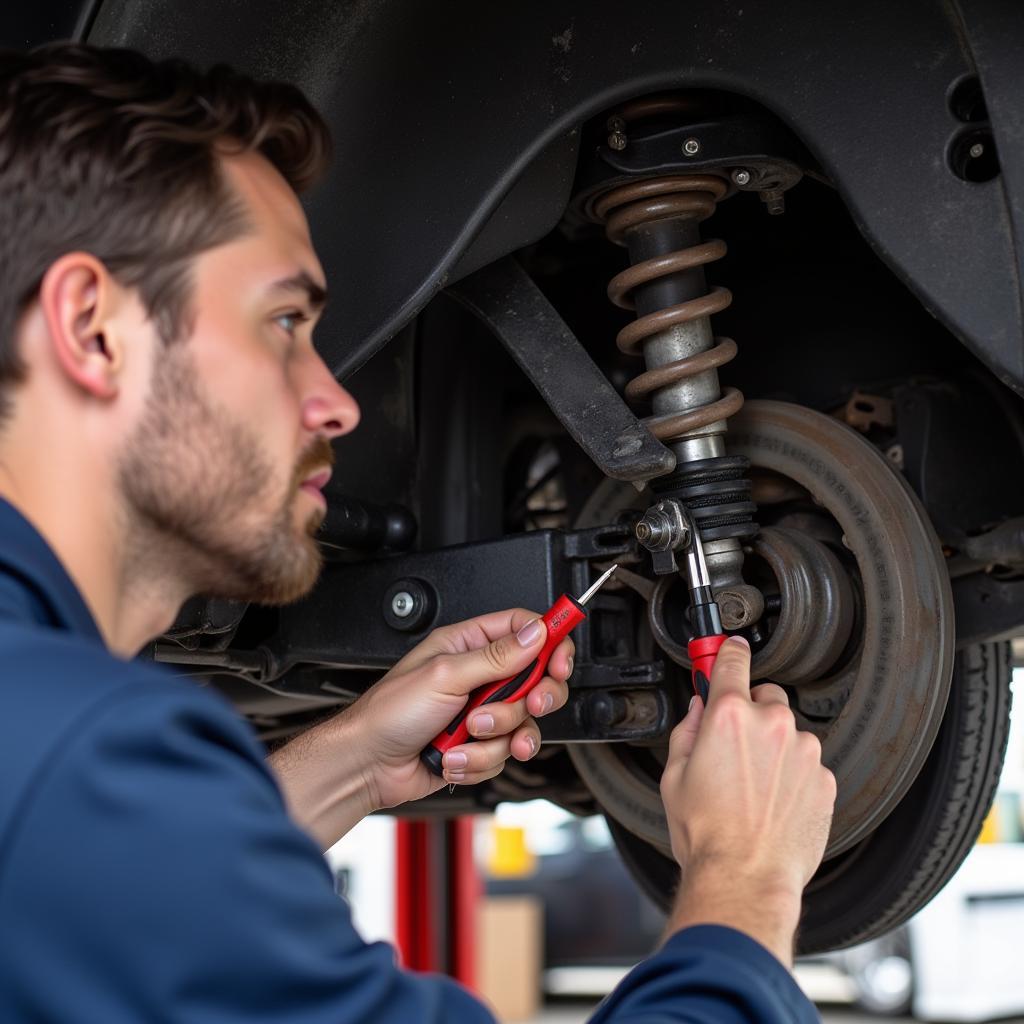That annoying squeak, clunk, or rattle coming from your car’s suspension? It’s not just irritating; it can be a sign of a serious problem. This comprehensive guide will help you diagnose and address your Car Suspension Noise Problem, whether you’re a car owner, mechanic, or automotive technician. Addressing these issues promptly can prevent further damage and ensure a safe and comfortable ride.
A well-functioning suspension system is crucial for a smooth and controlled driving experience. However, various factors can lead to noises, indicating potential problems that require attention. Understanding the different types of noises and their possible causes is the first step towards resolving your car suspension noise problem. Some problems, like worn suspension springs, might resemble issues you’d find in car suspension spring problems.
Understanding Your Car’s Suspension System
The suspension system is a complex network of components designed to absorb shocks from the road, keeping your tires in contact with the pavement and providing a comfortable ride. Key components include:
- Springs: These absorb impacts and support the vehicle’s weight.
- Shock absorbers/Struts: These dampen spring oscillations, controlling rebound and preventing excessive bouncing.
- Control arms: These connect the wheels to the chassis and allow them to move up and down.
- Bushings: These rubber components cushion and isolate various parts of the suspension, reducing noise and vibration.
- Sway bar/Stabilizer bar: This limits body roll during cornering, improving stability.
 Car Suspension Components Diagram
Car Suspension Components Diagram
Common Car Suspension Noise Problems
Different noises often indicate specific problems within the suspension system. Here are some common examples:
- Squeaking: Often caused by worn bushings or dry ball joints. This can be similar to issues found in older vehicles, like some of the saturn car chassis problems.
- Clunking: Can indicate loose or worn control arm bushings, ball joints, or tie rod ends.
- Rattling: Might be due to loose components, worn sway bar links, or a damaged exhaust system hitting the undercarriage.
- Knocking: Often suggests worn shock absorbers or struts. This can be particularly noticeable when driving over bumps or potholes.
- Banging: A loud banging noise might indicate a broken spring or a severely damaged component.
Diagnosing Your Car Suspension Noise Problem
Accurately diagnosing the source of the noise is crucial for effective repair. Here’s a step-by-step guide:
- Identify the type of noise: Is it a squeak, clunk, rattle, knock, or bang?
- Determine when the noise occurs: Does it happen when driving over bumps, turning, braking, or accelerating?
- Isolate the location of the noise: Is it coming from the front, rear, left, or right side of the vehicle? Some issues might be easier to diagnose, similar to determining car problems in the front.
- Inspect the suspension components: Look for signs of wear, damage, or looseness.
 Inspecting Car Suspension for Damage
Inspecting Car Suspension for Damage
What Causes Suspension Noise?
Several factors can contribute to car suspension noise problems:
- Wear and tear: Over time, components like bushings and ball joints wear out, leading to noises.
- Impact damage: Hitting potholes or curbs can damage suspension components.
- Corrosion: Rust can weaken suspension parts, making them more prone to failure.
- Lack of lubrication: Insufficient lubrication can cause squeaking and other noises.
- Improper installation: Incorrectly installed components can lead to premature wear and noise.
“Regular inspections and preventative maintenance are key to avoiding costly suspension repairs,” says John Miller, a certified automotive technician with over 20 years of experience. “Addressing minor issues early on can prevent them from developing into major problems.”
Fixing the Problem
Once you’ve diagnosed the issue, you can either repair it yourself or take your car to a professional mechanic. Simple fixes, like lubricating bushings or tightening loose bolts, can often be done at home. However, more complex repairs, such as replacing shock absorbers or control arms, are best left to professionals. You may even consider checking for Vermont used car problems before purchasing, to preemptively identify potential issues.
How Can I Prevent Future Suspension Issues?
Regular maintenance is the best way to prevent car suspension noise problems. This includes:
- Regular inspections: Have your suspension system inspected by a qualified mechanic at least once a year.
- Lubrication: Keep all moving parts properly lubricated.
- Careful driving: Avoid potholes and other road hazards.
- Prompt repairs: Address any suspension noises or issues as soon as they arise.
 Mechanic Repairing Car Suspension
Mechanic Repairing Car Suspension
Troubleshooting Specific Noises
Sometimes specific noises, like those experienced with smart car front suspension problems, can provide more direct clues.
What if I hear a clunking noise when going over bumps?
This could indicate worn control arm bushings, ball joints, or stabilizer bar links.
What if my car squeaks when turning the steering wheel?
This often points to dry or worn steering components, such as tie rod ends or ball joints.
“Ignoring suspension noises can lead to more serious problems, affecting your car’s handling and safety,” advises Susan Davis, a senior automotive engineer. “It’s always best to err on the side of caution and have any unusual noises checked out by a professional.”
Conclusion
Addressing your car suspension noise problem is vital for maintaining a safe and comfortable driving experience. By understanding the different types of noises, their potential causes, and how to diagnose and fix them, you can keep your suspension system in optimal condition and avoid costly repairs down the road. Remember, prompt attention to any unusual noises can save you time, money, and hassle in the long run. For further assistance or to schedule an inspection, feel free to connect with us at AutoTipPro. Call us at +1 (641) 206-8880 or visit our office at 500 N St Mary’s St, San Antonio, TX 78205, United States.






Leave a Reply